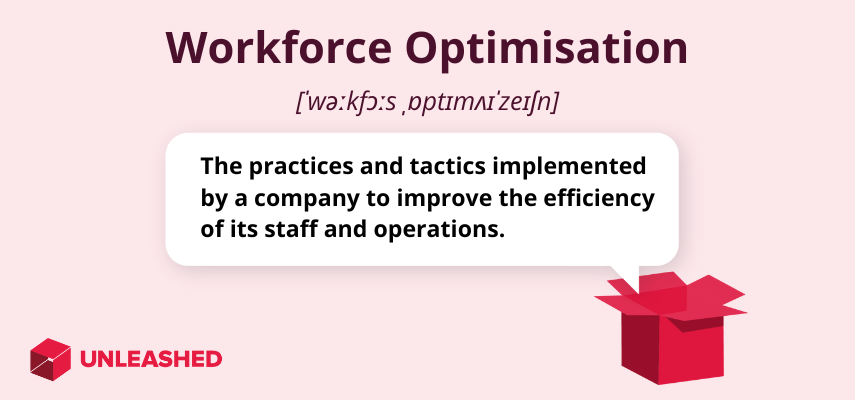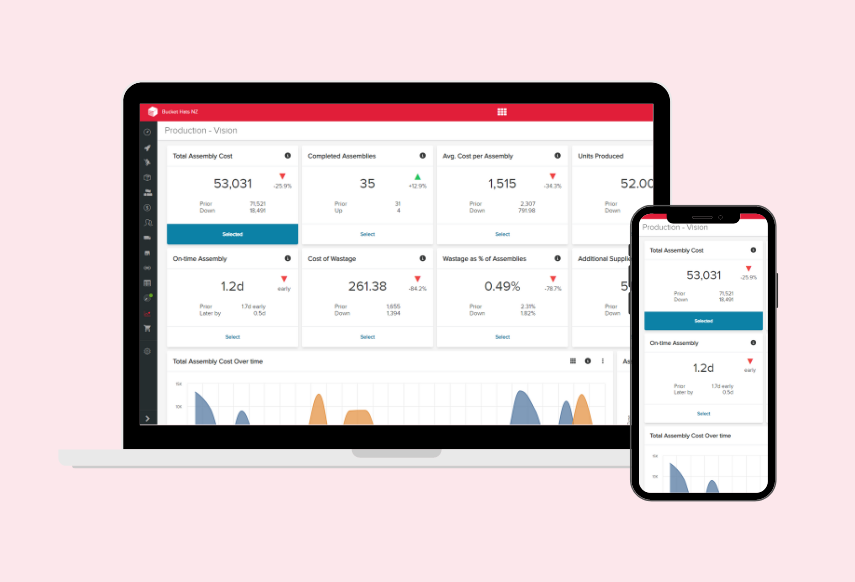
The objective of workforce optimisation is to reduce operational costs by boosting productivity and employee output. It’s an essential process for achieving maximum success in manufacturing.
This leads us to the real question: How does one optimise an entire workforce?
In this article, we highlight some practical workforce optimisation solutions, outline the importance of workforce scheduling optimisation, and explore the differences between workforce optimisation and workforce management. Let’s dive in.
What is workforce optimisation?

Workforce optimisation (WFO) refers to the practices and tactics a company implements to improve its employees and organisational efficiency. WFO touches every aspect of your business, from production, marketing, and sales to finance and employee satisfaction. It aims to streamline processes between your departments and employees to achieve maximum results.
WFO brings your production costs, scheduling, and customer satisfaction into alignment, ensuring your business runs effortlessly. Effective implementation of workforce optimisation strategies ensures you have the valuable workforce resources you need for the growth of your manufacturing operations.
What are the goals of workforce optimisation?
The primary goal of workforce optimisation strategies is to reduce operational costs.
Using data to leverage information WFO helps maximise employee and systems efficiency in a work smarter approach. But those aren’t the only aims.
The goals of workforce optimisation also include:
- Understanding your business down to its simplest of details
- Streamlining manufacturing operations to meet specific KPIs
- Refining communications and the flow of information and tasks within your business
- Reducing the potential for manufacturing waste and human error
- Empowering staff by matching their skills to jobs and tasks
- Having a customer-centric perspective
- Giving your employees the tools and resources they need to succeed
- Implementing a data-driven approach to optimise workforce processes
You can also add to this list any purposes specific to your unique company goals that can be achieved with a more efficient workforce.
Workforce optimisation vs workforce management
Workforce optimisation emphasises staff development and quality assurance at the employee level. It underlines the processes, strategies, and tools employed to assist staff in increasing their efficiency and productivity over the long term. In comparison, workforce management looks to enhance the day-to-day productivity of your entire organisation.
Both use scheduling tools. But unlike workforce management, workforce optimisation also monitors your employee’s quality and performance to reveal if further training or upskilling is required.
Benefits of workforce optimisation
The benefits of workforce optimisation are numerous and ongoing. It provides manufacturers with greater efficiency, fewer compliance issues, reduced costs, empowered employees, and better customer service satisfaction.
Here’s how.
Greater efficiency
WFO practices improve manufacturing efficiency and eliminate waste. They also reduce incidents of lost time and material waste. Initiating new processes, implementing software solutions, and streamlining the flow of information can boost productivity by up to 30%.
Cost savings
Workforce optimisation strategies allow manufacturers to grow their revenue without the need for new infrastructure. They enable you to recognise savings through a reduction in recruitment costs, lower turnover costs, and the additional indirect costs of an unengaged workforce.
Fewer compliance issues
Optimising your workforce minimises the risk of miscommunication and mistakes being made. It also reduces the potential for compliance issues while enabling you to quickly identify and correct any that may occur. Greater compliance lifts your reputation within your industry, and amongst your customers, and it improves your standing with compliance monitors.
Empowered employees
Empowered employees are staff who are equipped with the tools, resources, and knowledge needed to undertake their daily tasks.
Engaged and empowered employees are more satisfied with their jobs. Manufacturers can leverage this to attract, hire, and keep the best people in their industry while establishing a reputation as a preferred place to work.
Customer service satisfaction
Workforce optimisation strategies directly lead to higher rates of customer satisfaction.
Contented and inspired employees give better customer service.
The streamlined processes of WFO enable staff to respond more effectively to your customers and their needs, quickly identifying issues to resolve them faster.
 Workforce optimisation can be applied to the manufacturing industry to increase employee productivity and lower costs.
Workforce optimisation can be applied to the manufacturing industry to increase employee productivity and lower costs.
How workforce optimisation works
People are your most valuable resource. Finding and retaining the right talent is a function of workforce planning that should align with your business's HR goals. In comparison, workforce optimisation works by considering the talent you already have – their current knowledge or skill gaps – and looking for ways to optimise their input.
How to optimise your workforce in four steps:
- Analyse your current workforce to determine what knowledge, skills, and experience they have. Identify what shortfalls exist and any areas for improvement.
- Determine your future business needs. Based on the analysis of your current workforce, ascertain what your future staffing needs will be.
- Identify gaps between your current workforce and future staffing requirements. This doesn’t refer specifically to staffing numbers but to the competencies and expertise employees currently bring versus future staffing needs.
- Develop strategies to fill identified gaps and inefficiencies in employee skills through training, upskilling, cross-training, and other tactics to optimise your workforce.
Workforce optimisation should be an always-on strategy. Repeat this process on an ongoing basis, or whenever productivity and efficiency are declining.
Examples of workforce optimisation in manufacturing
Workforce optimisation is especially potent in the manufacturing industry, where lean activities and waste reduction are frequently being sought out.
The three key areas where you can implement WFO in your manufacturing activities are:
- Production
- Inventory
- Scheduling
Let’s look at a few ways you can optimise these processes.
Production optimisation
Optimising your production workforce involves streamlining your production process to increase efficiency and reduce waste.
One way this can be achieved is through the implementation of work-in-progress procedures.
Another is to train your operators on how to best respond to automated alarms and insights on your production monitoring systems.
Alternatively, you might consider a complete overhaul of your factory layout, rearranging machines and tools to ensure labour and timesaving strategies at the point of use.
Inventory optimisation
Inventory optimisation involves forecasting demand to ensure you have the right products available, at the right time.
You can optimise your workforce by applying inventory optimisation techniques to workforce management. For example, using data and predictive analytics to estimate the future demand for products, the optimal inventory levels, locations, and replenishment policies for each product, and adjusting the workforce accordingly.
Analytics can be used to track inventory metrics and KPIs, such as fill rate and turnover rates to identify areas where improvements to workforce productivity and efficiency can be made.
Inventory optimisation also allows you to monitor and balance your inventory across multiple locations, channels, and stages, and reallocate the workforce as and where needed.
Scheduling optimisation
Establishing optimal schedules for each of your employees means you can align your workforce with the production schedule. Scheduling optimisation uses demand forecasting to schedule your production lines to ensure they are running at maximum efficiency.
Additionally, you can monitor and balance schedules across multiple employees, departments, and locations, reallocating your workforce to where they are needed most. The use of data and analytics enables you to identify and eliminate excess, or inefficient activities.
Scheduling performance measurements that track and evaluate scheduling KPIs – such as compliance rate, utilisation rate, and cost per hour – give a good indication of where changes can be made to improve workforce productivity and efficiency.
Workforce optimisation strategies for manufacturers
By focusing on a combination of these five WFO strategies you can create a workforce who are aligned with your business goals and objectives while achieving increased productivity, and greater employee satisfaction.
Workforce scheduling optimisation
Workforce scheduling optimisation is a strategy that aims to improve the efficiency and effectiveness of manufacturing operations by allocating the right workers to the right tasks at the right time.
Benefits of workforce scheduling optimisation include:
- Reducing labour costs by matching the supply and demand of workers, avoiding overstaffing or understaffing, and minimising downtime and overtime.
- Improving employee satisfaction by considering their preferences, skills, availability, and well-being in creating schedules, and allowing them to swap shifts or request time off easily.
- Enabling more streamlined, flexible, and resilient operations by adapting to changing customer needs, production plans, and market conditions, and responding to disruptions quickly and proactively.
- Leveraging Industry 4.0 technologies such as artificial intelligence, machine learning, data analytics, and digital twins to automate and optimise scheduling processes, enhance decision-making, and increase visibility and transparency.
Workforce scheduling optimisation improves your production scheduling because it ensures your operations and production lines are running at their maximum efficiency.
Performance management
Performance management is a workforce optimisation strategy that helps manufacturers improve their productivity, quality, and profitability.
Performance management involves:
- Setting clear and measurable goals for employees and teams that align with your organisation’s vision and objectives.
- Monitoring and evaluating performance using data and feedback to identify strengths and weaknesses, and to recognise achievements.
- Providing coaching and training to employees to help them develop their skills and competencies, and to address performance gaps.
- Implementing incentives and rewards to motivate employees and foster a culture of excellence and continuous improvement.
Performance management is an ongoing process of communication and review. Ensuring workers have the resources and recognition they need to perform their tasks well and meet strategic goals.
Skills development
Skills development is a workforce optimisation strategy that helps manufacturers enhance their employees’ capabilities and competencies.
Skills development involves:
- Assessing the current and future skills required by the business and its workforce and identifying the gaps and opportunities for improvement.
- Designing and delivering training programs that are relevant, effective, and engaging for the employees, and that align with your organisation’s goals and standards.
- Evaluating the impact and outcomes of the training programs on the employees’ performance, satisfaction, and retention, and your manufacturing productivity, quality, and profitability.
- Updating and adapting the training programs based on feedback, data, and changing business needs.
Skills development requires a commitment to invest in your staff.
Trained and knowledgeable staff are more effective in their roles and the ROI will be realised through greater efficiency, lower costs, and ultimately increased profitability.
Time tracking
Time tracking is a workforce optimisation strategy that helps manufacturers measure and improve the efficiency and effectiveness of their employees and processes.
Time tracking involves:
- Recording the time spent by employees on different tasks, projects, and activities using manufacturing software or devices.
- Analysing the time data to identify patterns, trends, and bottlenecks in the workflow, and to evaluate the performance of employees and teams.
- Optimising the allocation and utilisation of resources, such as labour, equipment, and materials, based on the time data, business goals, and priorities.
- Enhancing the productivity, quality, and profitability of the organisation by reducing waste, improving communication, and increasing customer satisfaction.
Time tracking is not about micro-managing employees or monitoring their attendance. It’s taking a holistic approach to understanding the efficiency of operations compared to the hours spent.
Tools and technology
Tools and technology are great workforce optimisation strategies for manufacturers.
They can be used to optimise the workforce through:
- Automation – to help manufacturers reduce manual labour, increase efficiency, and improve quality. For example, robots can be used to perform repetitive tasks, such as assembly or packaging, while employees can focus on more complex and creative tasks.
- Data analytics – can help manufacturers gain insights into their operations, identify areas for improvement, and make data-driven decisions. For example, manufacturers can use data analytics to monitor production processes, track inventory levels, and predict maintenance needs.
- Collaboration tools – will help manufacturers improve communication and teamwork among employees, suppliers, and customers. For example, cloud-based platforms can be used to share documents, schedules, and feedback in real time.
- Training tools – help manufacturers enhance their employees’ skills and knowledge. For example, e-learning platforms can be used to deliver training programs that are interactive, engaging, and accessible from anywhere.
By leveraging these tools and technologies, manufacturers can optimise their workforce’s performance, reduce costs, and improve customer satisfaction.
 Manufacturing software is an example of how tools and technology can be used to analyse performance and aid in workforce optimisation.
Manufacturing software is an example of how tools and technology can be used to analyse performance and aid in workforce optimisation.
Workforce optimisation solutions
Workforce optimisation solutions are most commonly software tools that combine analytical data, quality management, call centre recordings, coaching, and text analytics, along with employee feedback to enhance workforce processes. They aim to improve your employee and organisational efficiency, using this data to reduce operational costs.
Data analysis from WFO solutions uses the information collected to evaluate and understand your operational costs, customer satisfaction scores, and employee performance.
You can use these data-driven insights to make more informed decisions around:
- Staffing levels
- Production scheduling
- Staff training
- Performance management
These enable you to make informed decisions across all areas of your manufacturing operations.
Workforce optimisation software
Workforce optimisation software combines interactive analytics, quality management, call recording, coaching, speech and text analytics, performance management, surveying, and feedback to optimise workforce processes.
WFO software solutions can help manufacturers improve operational efficiency and increase productivity with:
- Scheduling tools to optimise productivity while reducing burnout
- Accurate multi-skill, multi-channel forecasts and schedules
- Full capture of interactions to detect trends, automate the quality process, and identify where good and bad customer service occurs
- Shared operational metrics, KPIs, and service level agreement statistics to maximise the contribution
- Pre-built integrations to seamlessly amalgamate CRM and other software systems
- Multichannel evaluations, real-time desktop monitoring and assistance, and automated scoring and evaluation selection to enhance quality management
- Streamlining your processes to maximise results, leading to greater productivity and efficiency
- Error reductions and deep-dive insights into every aspect of your operations
- Process automation to reduce employee workloads and increase manufacturing efficiency
Workforce optimisation software collects and analyses a myriad of data to assist you in making informed decisions that will optimise your workforce processes.
